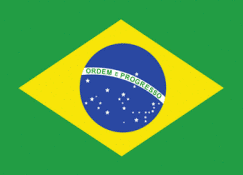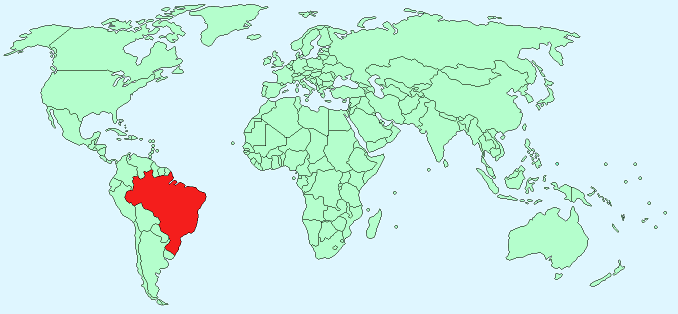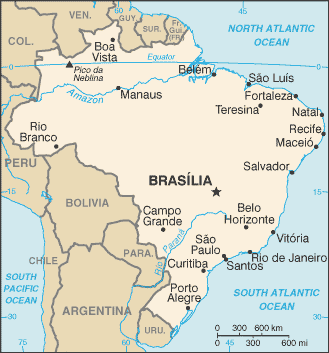Brazil


Continent – South America
Size – 8,511,965 km²
Geography – Mainly flat with some hills in the north
Language – Portuguese (official), Spanish, English, French
Religion – 73.6% Roman Catholic, 15.4% Protestant, 7.4% None, 3.4% Other
Monetary Unit – Real
Natural Resources – bauxite, gold, iron ore, manganese, nickel, phosphates, platinum, tin, uranium, petroleum, timber
Agriculture – coffee, soybeans, wheat, rice, corn, sugarcane, cocoa, citrus; beef
Industry – textiles, shoes, chemicals, cement, lumber, iron ore, tin, steel, aircraft, motor vehicles and parts, other machinery and equipment

Neighbouring Countries – Uruguay, Argentina, Paraguay, Bolivia, Peru, Colombia, Venezuela, Guyana, Suriname, French Guiana
Population – 202,656,788 (2014)
Population Growth Rate – 1.00%
Average Life Expectancy – 72.24
Capital City – Brasilia (population 2,852,372)
Most Populated City – Sao Paulo (population 11,895,893)
Highest Mountain – Pico da Neblina (3,014 m)
Longest River – Amazon (6,400 km)
Climate – Amazon region – tropical – 27°C to 32°C, central Brazil – 13°C to 32°C all year, east coast – 22°C to 32°C all year, southern region – mild winters 9°C to 20°C and hot summers 16°C to 31°C
Yearly Rainfall – Amazon region 180cm approx, central region 160cm approx mostly in October to March, east coast 220cm mostly in December to May, southern region 110cm approx
Plant Life – Euphorbiaceae (rubber) tree, mangroves, cocoa tree, dwarf palm, pineapple, fig, custard apple, mango, banana, guava, caju, coconut, jack-fruit tree, orange, sugar, cotton, grasses, shrubland, Brazil nut trees, brazilwood, myriad palm, ceiba, vines and creepers, rosewood, orchids, water lilies
Animal Life – 750 mammal species including puma, jaguar, ocelot, rare bush dog, fox, peccary, tapir, anteater, sloth, opossum, armadillo, deer, monkey species. Reptile species include lizards, snakes, turtles, crocodiles, alligators and caimans.
Bird Life – 1,500 species of birds including macaws, toucans, parrots
Aquatic Life – 2,000 fish species including piranha, turtles, tropical fish
Harvard Reference for this page:
Heather Y Wheeler. (2015). Brazil. Available: https://www.naturalhistoryonthenet.com/Facts_Figures/Country_Facts/brazil.htm. Last accessed Monday, July 18, 2016
Facts and Figures Pages
